
French postcard in the Collection Noire by Editions Hazan, Paris, no. 6011, 1988. Photo: Sam Levin. Jean Renoir and un unidentified cinematographer at the set of La bête humaine/The Human Beast (1938).

French postcard by L'Aventure Carto, Cinéastes, no. 6, 2003. Photo: Marcel Thomas / Collection Gérard Gagnepain. (Edition of 120 ex.)

American postcard by Beulah Roth, Mader, Calif., no. 35-5122, 1980. Photo: Sanford Roth. Caption: Beverly Hills, 1953. Photographed at his home after completing the filming of Rumer Godden's book 'The River', 1953.
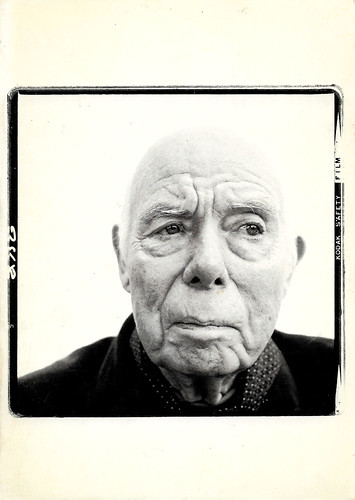
American postcard by Fotofolio, New York, no. RA24. Photo: Richard Avedon, 1972. Caption: Jean Renoir, Director, Beverly Hills, California, 4-11-72.
Wounded in battle and watching films with his leg elevated
Jean Renoir was born in 1894 in Paris, France. He was the son of the famous Impressionist painter Pierre-Auguste Renoir and had a happy childhood. Actor Pierre Renoir was his brother, and cinematographer Claude Renoir was his nephew.
Jean fought in the French army during World War I and was wounded in battle. His wounds never healed properly and he suffered from it for the rest of his life. He recuperated by watching films with his leg elevated. Later, he was honoured with the Croix de Guerre.
After the end of World War I, he moved from scriptwriting to filmmaking. He married his father's last model, Catherine Hessling. Renoir wanted to make a star of her and directed her in Catherine ou Une vie sans Joie/Backbiters (1924).
His second feature was the Emile Zola adaptation Nana (1926) starring Hessling, Werner Krauss, and Jean Angelo. The film's extravagances include two magnificent set pieces – a horse race and an open-air ball. The film never made a profit, and the commercial failure of the film robbed Renoir of the opportunity to make such an ambitious film again for several years.
Renoir gradually sold paintings inherited from his father to finance his films. Renoir and Hessling separated in 1930, although he remained married to her until 1943. His next partner was Marguerite Renoir, whom he never married, although she took his name.

French postcard by Editions Cinémagazine, no. 411. Catherine Hessling as the title character in Nana (Jean Renoir, 1926), based on the homonymous novel (1880) by Emile Zola.
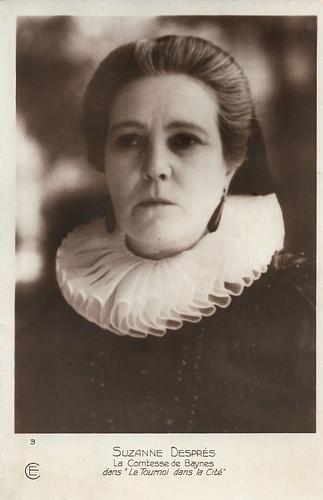
French postcard by Cinémagazine-Edition, no. 3. Photo: Suzanne Desprès as La Comtesse de Baynes in Le tournoi dans la cité/The Tournament (Jean Renoir, 1928). The film was scripted by Henry Dupuis-Mazuel. Sets by Robert Mallet-Stevens, costumes by George Barbier, with interiors shot at the Studio of St. Maurice and exteriors shot at Carcassonne. While the first night took place in Brussels in December 1928, the Parisian premiere was on 9 February 1929 at the cinema Marivaux.
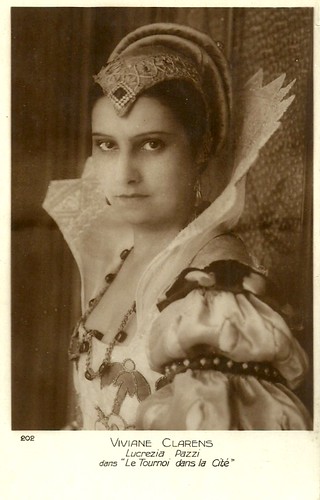
French postcard by Cinémagazine-Edition, no. 202. Photo: Viviane Clarens as Lucrezia Pazzi in Le tournoi dans la cité/The Tournament (Jean Renoir, 1928).

French postcard by Cinémagazine-Edition, no. 207. Photo: Enrique (de) Rivero as Henri de Rogier in Le tournoi dans la cité/The Tournament (Jean Renoir, 1928).

French postcard by Cinémagazine-Edition, no. 208. Photo: Blanche Bernis as Cathérine de Médicis in Le tournoi dans la cité/The Tournament (Jean Renoir, 1928).
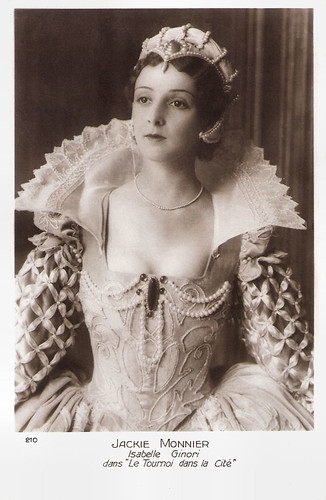
French postcard by Cinémagazine-Edition, no. 210. Photo: Jackie Monnier as Isabelle Ginori in Le tournoi dans la cité/The Tournament (Jean Renoir, 1928).
The first foreign-language film to nominated for the Best Picture Oscar
In 1931 Jean Renoir directed his first sound films, the comedy On purge bébé/Baby's Laxative (1931), based upon the play by Georges Feydeau, and La Chienne/The Bitch (1931). with Michel Simon.
The following year he made Boudu sauvé des eaux/Boudu Saved from Drowning (1932), a farcical sendup of the pretensions of a middle-class bookseller and his family, who meet with comic, and ultimately disastrous, results when they attempt to reform a vagrant played by Michel Simon.
He then directed La Nuit du carrefour/Night at the Crossroads (1932), based on a novel by Georges Simenon and starring Renoir's brother Pierre Renoir as Simenon's popular detective, Inspector Maigret.
Partie de campagne/A Day in the Country (1936) was based on a short story by Guy de Maupassant, who was a friend of Renoir's father. It chronicles a love affair over a single summer afternoon in 1860 along the banks of the Seine. Renoir never finished filming due to weather problems, but producer Pierre Braunberger turned the material into a release in 1946, ten years after it was shot.
By the middle of the 1930s, Renoir was associated with the Popular Front. Several of his films, such as Le Crime de Monsieur Lange/The Crime of Monsieur Lange (1935) with René Lefèvre, La vie est à nous/Life Belongs to Us (1936) and La Marseillaise (1938), reflect the movement's politics.
Erich von Stroheim and Jean Gabin starred in one of his better-known films, the war film La Grande Illusion/The Great Illusion (1937). A film on the theme of brotherhood, relating a series of escape attempts by French POWs during World War I. It won the Best Artistic Ensemble award at the Venice Film Festival and was the first foreign-language film to receive a nomination for the Oscar for Best Picture.
He followed it with another success, La Bête Humaine/The Human Beast (1938), a Film Noir based on the novel by Émile Zola and starring Simone Simon and Jean Gabin.
With an ensemble cast, Renoir made La Règle du Jeu/The Rules of the Game (1939), a satire on contemporary French society. Renoir himself played the character Octave, who serves to connect characters from different social strata. The film was his greatest commercial failure. A few weeks after the outbreak of World War II, the film was banned by the government.
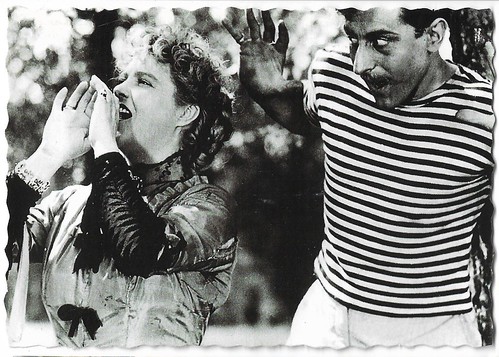
French postcard by Festival International du Film / Cine Classics. Jane Marken as Mme Dufour and Jacques B. Brunius as Rodolphe in Une partie de campagne (Jean Renoir, 1936), starring Sylvia Bataille and George Darnoux.

French postcard by Crépa, Editeur, Paris. Photo: Sam Lévin / Production R.A.C. Marcel Dalio, Gaston Modot and Jean Gabin in La grande illusion/The Grand Illusion (Jean Renoir, 1937).

French postcard by Crépa, Editeur, Paris. Photo: Sam Lévin / Production R.A.C. Jean Gabin, Dalio, Carette, Gaston Modot and Pierre Fresnay in La grande illusion/The Grand Illusion (Jean Renoir, 1937).
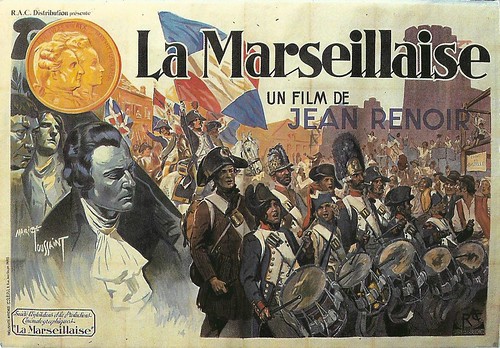
French postcard by Abeille Cartes / Ed. Lyna, Paris. Series of the commemoration of the bicentennial of the French Revolution. Poster or lobbycard of La Marseillaise (Jean Renoir, 1937), starring Pierre Renoir and Lise Delamare as Louis XVI and Marie-Antoinette. Poster design by Maurice Toussaint.
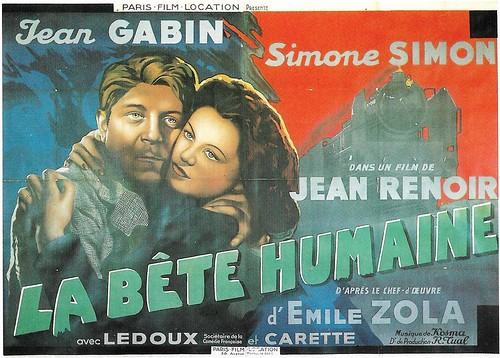
French postcard by Ed. Hazan, Paris. Poster or lobbycard of La bête humaine/The Human Beast (Jean Renoir, 1938), starring Jean Gabin and Simone Simon.
A coming of age story of three young girls in colonial India
Jean Renoir was a known pacifist and supporter of the French Communist Party, which made him suspect in the tense weeks before the war began. In July 1939, Renoir went to Rome with Carl Koch and his future second wife Dido Freire to work on the script for a film version of the opera 'Tosca'. He abandoned the project to return to France and make himself available for military service.
Renoir and Dido Freire left France in 1941 during the German invasion and moved to Hollywood. Renoir had difficulty finding projects that suited him.
His first American film, Swamp Water (1941), was a drama starring Dana Andrews and Walter Brennan. He co-produced and directed an anti-Nazi film set in France, This Land Is Mine (1943), starring Maureen O'Hara and Charles Laughton.
The Southerner (1945) is a film about Texas sharecroppers that is often regarded as his best American film. He was nominated for an Oscar for Directing for this work.
Diary of a Chambermaid (1946) is an adaptation of the Octave Mirbeau novel, 'Le Journal d'une femme de chambre', starring Paulette Goddard and Burgess Meredith.
His The Woman on the Beach (1947), starring Joan Bennett and Robert Ryan, was heavily reshot and reedited after it fared poorly among preview audiences in California.
Both films were poorly received and they were the last films Renoir made in America. At this time, Renoir became a naturalised US citizen. In 1949 Renoir traveled to India to shoot The River (1951), his first colour film. Based on the novel by Rumer Godden, the film is both a meditation on human beings' relationship with nature and a coming of age story of three young girls in colonial India. The film won the International Prize at the Venice Film Festival in 1951.

French postcard by P.C., Paris, no. 73. Photo: G.L. Manuel Frères, 63. René Lefèvre, wearing the outfit from Le crime de M. Lange/The Crime of Monsieur Lange (Jean Renoir, 1936).

French postcard by Massilia. Photo: Filma Albatros. Junie Astor in Les Bas-fonds/The Lower Depths (Jean Renoir, 1936).
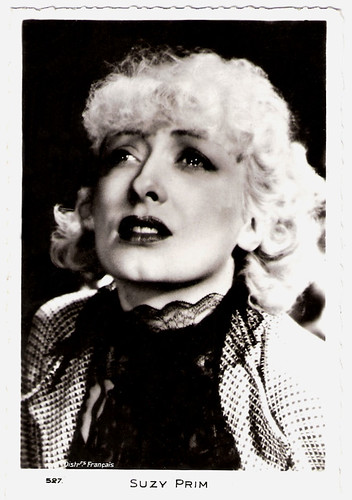
French postcard by Collection Chantal, Paris, no. 527. Photo: Distributeurs Français. Suzy Prim in Les bas-fonds/The Lower Depths (Jean Renoir, 1936).
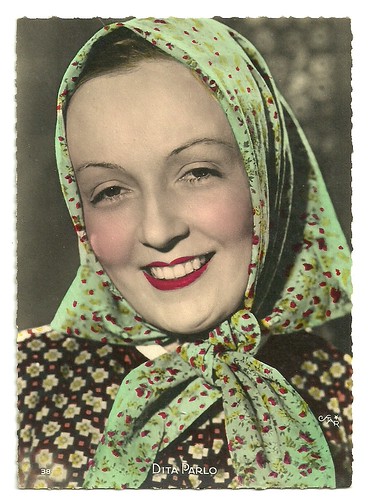
French postcard. Photo: Star. Dita Parlo in La Grande Illusion/The Grand Illusion (Jean Renoir, 1937).

Italian postcard by Ballerini & Fratini Firenze Editori, no. 4248. Photo: Scalera Film. Imperio Argentina in Tosca (Jean Renoir, Carl Koch, 1941). While Renoir started the film, his scriptwriter and assistant Carl Koch finished the film and shot most of it. Luchino Visconti was an assistant-director for this film. This postcard refers to a scene in which Argentina sings the aria of 'Caro mio ben' by Giuseppe Giordani.

Italian postcard by ASER (A. Scarmiglia Edizioni Roma), no. 13. Carla Candiani in Tosca (Carl Koch, Jean Renoir, 1939-1941).
The twin human needs for freedom and for emotional and economic security
After returning to work in Europe, Jean Renoir made a trilogy of colour musical comedies on the subjects of theatre, politics, and commerce: Le Carrosse d'or/The Golden Coach (1953) with Anna Magnani, French Cancan (1954) with Jean Gabin and María Félix, and Eléna et les hommes/Elena and Her Men (1956) with Ingrid Bergman and Jean Marais.
During the same period, Renoir produced Clifford Odets' play 'The Big Knife' in Paris. He also wrote his own play, 'Orvet', and produced it in Paris featuring Leslie Caron.
Renoir made his next films with techniques adapted from live television. Le Déjeuner sur l'herbe/Picnic on the Grass (1959), starring Paul Meurisse and Catherine Rouvel, was filmed on the grounds of Pierre-Auguste Renoir's home in Cagnes-sur-Mer, and Le Testament du docteur Cordelier/The Testament of Doctor Cordelier (1959), starring Jean-Louis Barrault, was made in the streets of Paris and its suburbs.
Renoir's penultimate film, Le Caporal épinglé/The Elusive Corporal (1962), with Jean-Pierre Cassel and Claude Brasseur, is set among French POWs during their internment in labour camps by the Nazis during World War II. The film explores the twin human needs for freedom, on the one hand, and emotional and economic security, on the other.
Renoir's loving memoir of his father, 'Renoir, My Father' (1962) describes the profound influence his father had on him and his work. As funds for his film projects were becoming harder to obtain, Renoir continued to write screenplays for income.
He published a novel, 'The Notebooks of Captain Georges', in 1966. Captain Georges is the nostalgic account of a wealthy young man's sentimental education and love for a peasant girl.
Renoir's last film is Le Petit théâtre de Jean Renoir/The Little Theatre of Jean Renoir (1969). The film is a series of three short films made in a variety of styles. It is, in many ways, one of his most challenging, avant-garde, and unconventional works. Unable to obtain financing for his films and suffering declining health, Renoir spent his last years receiving friends at his home in Beverly Hills and writing novels and his memoirs.
Renoir's memoir, 'My Life and My Film's, was published in 1974. In 1975, he received a Lifetime Achievement Oscar, and the government of France elevated him to the rank of commander in the Légion d'honneur.
Jean Renoir passed away in 1979 in Beverly Hills, Los Angeles, of a heart attack. Although he was an American citizen, he was buried in France following a state funeral. From 1957 till his death in 1979, he was married to Dido Freire. His son Alain Renoir (1921-2008) became a professor of English and comparative literature at the University of California, Berkeley, and a scholar of medieval English literature.
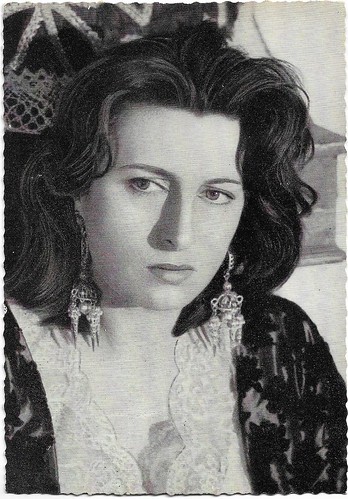
German film card by Filmbilder-Filmvertrieb Ernst Freihoff, Essen, no. 100. Photo: Dial/Unitalia Film. Anna Magnani as Camilla in the comedy La carrozza d'oro/ La carrosse d'or/The Golden Coach (Jean Renoir, 1952).

Dutch postcard by Gebr. Spanjersberg N.V., Rotterdam, Dutch licency holder for Universum-Film Aktiengesellschaft, Berlin-Tempelhof, no. 1501. Photo: Serge Beauvarlet / Franco London Film, Paris. Jean Gabin and Maria Félix in French Cancan (Jean Renoir, 1954).
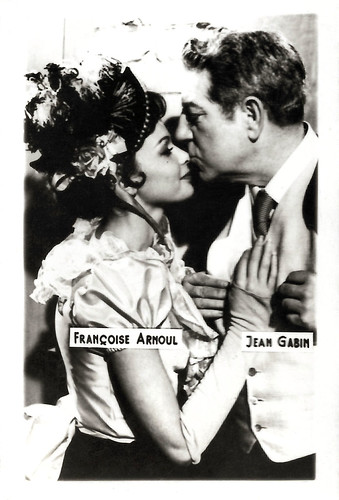
Small Romanian collectors card. Françoise Arnoul and Jean Gabin in French Cancan (Jean Renoir, 1955).
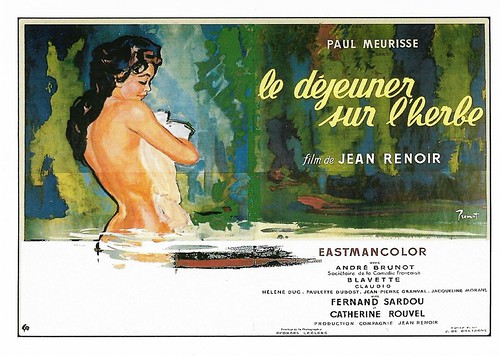
French postcard by Encyclopédie du cinéma, ADAGP, Paris. Poster or lobbycard of Le déjeuner sur l'herbe (Jean Renoir, 1959), starring Paul Meurisse and Catherine Rouvel. Poster design by Pierre-Laurent Brenot.

Italian programme card for Il Cinema Ritrovata 2012. Photo: publicity still for La Grande Illusion (Jean Renoir, 1937) with Jean Gabin and Pierre Fresnay.
Sources: Wikipedia, and IMDb.
No comments:
Post a Comment